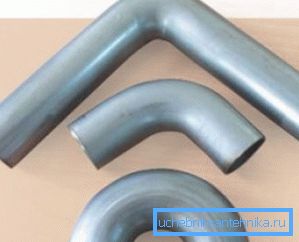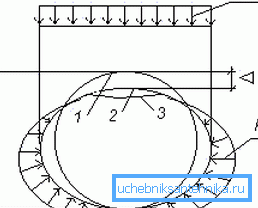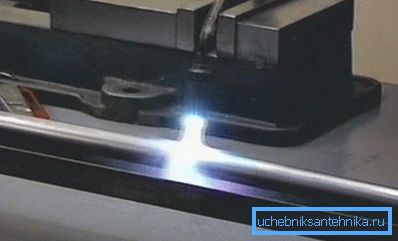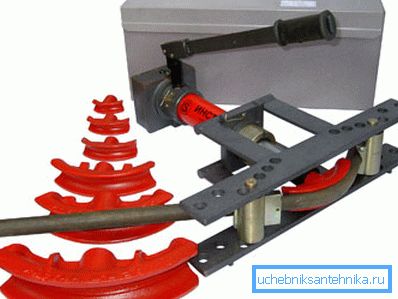Pipe bending: all the features of the process
When installing water and heating systems, you need to know how to properly bend the pipe. With this operation, it is necessary to avoid breaking it, breaching the integrity and correctly calculating the angle of rotation.
Bending is a process during which, under the influence of external loads, the product is replaced by the inclination of the axis.

Process features

- Elastic-plastic and elastic deformations are created in the walls of products during bending.. A tensile stress appears on the outer portion of the fold, and a compressive strain appears on the inner portion. According to these influences, the tilt of the axis of the elements changes.
- During the operation, the cross-sectional shape at the bent location changes. Its annular profile becomes oval. The highest ovality has the middle of the deflection, the deformation decreases to its end and the beginning.
- Making the calculation of the pipe for bending, remember that the ovality of its cross section in a deformed place should not be higher: for products with a cross section up to 20 mm - 15%, more than 20 - 12.5%.
- On the concave bend there may be folds, especially for thin-walled products..
Note! The folds and the ovality of the fold adversely affect the operation of the system. They reduce its permeability, increase the level of hydraulic resistance and serve as a site for clogging of sewage systems. The strength of the pipe to bend at the same time decreases.
Minimum allowed radii are flexible

Government standards contain a standard such as “minimum bending radius of a pipe”.
Its value for metal counterparts, compensators, taps is given below.
- When bent with heating and packing with sand - not less than 3.5DH (letters mean outer diameter)
- When working on a pipe bending machine (cold) - not less than 4DH.
- When bending to produce semi-corrugated folds and heating elements with a gas burner or in a furnace, it is not less than 2.5DH.
- For steeply bent sewer branches produced by the method of punching or hot pulling - not less than 1DH.
Note! It is permissible to make elements having a fold less than the above. At the same time, the production method must ensure that their walls will thin out no more than 15% of the thickness. The bending strength of the profile pipe must match the calculated.
Necessary formulas and tables
The length of the part (L) required for the manufacture of the curved place is according to the following formula:
L = 0.0175 • R •? + L, where:
- R is the bend radius, in mm;
- ? - this is its angle, in degrees;
- l is a straight spot, 100/300 long, which is needed to grip a product with a tool or machine.
The calculation of the bending of the pipe should take into account the length of the bent element:
A =? •? / 180 (R + DH / 2), where:
- ?= 3.14;
- R is the radius of the site, in mm;
- ? - is the angle of bending, in degrees;
- DH is the outer diameter of the product.
The table below shows the minimum bend radii in millimeters for brass and copper products (GOST No. 494/90 and GOST No. 617/90), based on their diameter and the desired length of the free side for gripping / clamping.
| External diameter | Minimum bend radius | The minimum length of the free part |
| 3 | 6 | ten |
| four | eight | 12 |
| 6 | 12 | 18 |
| eight | sixteen | 25 |
| ten | 20 | thirty |
| 12 | 24 | 35 |
| 15 | thirty | 45 |
| 18 | 36 | 50 |
| 24 | 72 | 55 |
| thirty | 90 | 60 |
Below is a table for steel analogues according to GOST №3262 / 75.
| Dimensions | Minimum bend radius | The minimum length of the free part | ||
| Conditional pass | External diameter | hot | cold | |
| eight | 13.5 | 40 | 80 | 40 |
| ten | 17 | 50 | 100 | 45 |
| 15 | 21.3 | 65 | 130 | 50 |
| 20 | 26.8 | 80 | 160 | 55 |
| 25 | 33.5 | 100 | 200 | 70 |
| 32 | 42.3 | 130 | 250 | 85 |
| 40 | 48 | 150 | 290 | 100 |
| 50 | 60 | 180 | 360 | 120 |
| 65 | 75.5 | 225 | 450 | 150 |
| 80 | 88.5 | 265 | 530 | 170 |
| 100 | 114 | 340 | 680 | 230 |
When making a calculation of the fold with your own hands, consider the smallest radii, based on the diameter and wall thickness of steel pipes.
| Diameter, mm | Minimum bend radius at a certain wall thickness | |
| up to 2 mm | more than 2 mm | |
| 5/20 | 4D | 3D |
| 20/35 | 5D | 3D |
| 35/60 | 6D | 4D |
| 60/140 | 7D | 5D |
How to bend the plot yourself
There is a universal and simple formula for calculating a pipe for bending - this is its 5 diameters.
Perform the calculation, taking for example the detail section of 1.6 cm.
- For proper manufacturing need to get? circle.
- First, we obtain the desired radius: 16 • 5 = 80 mm. The next stage is the calculation of the starting points for the precise bending of the angle.
- For this purpose, it is necessary to use the formula C = 2? • R: 4. In it, C is the pipe length required for operation,? = 3.14, R is the desired radius.
- Substitute the figures in the formula: 2 • 14 • 80: 4 = 125 millimeters. This is the length of the section for which the minimum bending radius of a metal-plastic pipe or any other is 80 mm.
If you need to bend the pipes, you should have a pipe bender.
Such manual devices are divided into two types.

- In segment analogs, the operation is carried out on the basis of special templates. Their shape is designed for the exact diameter, which is needed and the shape of the fold. With this tool it is possible to bend pipes up to 180 °. Its price is relatively low.
- Dorn equipment carries out work without the slightest flaws. The advantage of this device is the segment moving inside the product. It prevents deformations and makes it possible to do work in several places. It is better not to do such a machine for bending profile pipes with your own hands, but to get ready.
Having made the calculation, mark the areas on the element according to its results. Next on the instrument, put the desired degree or pattern. Then insert the product into the fixture and perform the operation.
Conclusion
Bending elements in the installation of various engineering systems should be based on accurate calculations. Otherwise, you can break the product or assemble the pipeline with reduced efficiency. The video in this article will continue its theme.